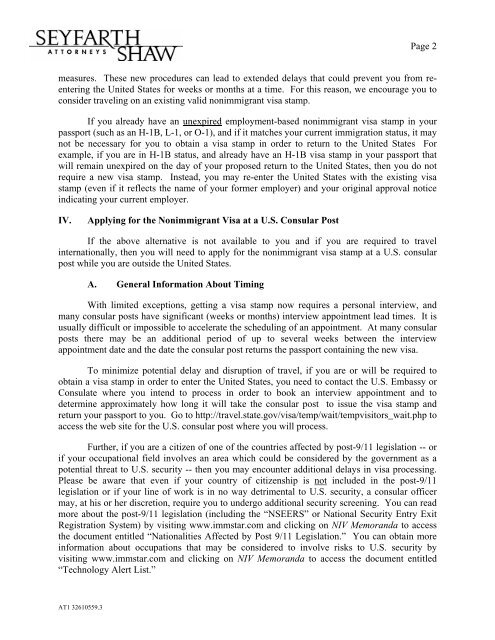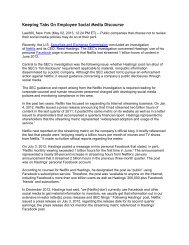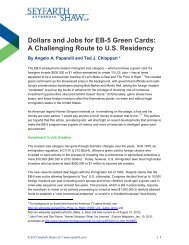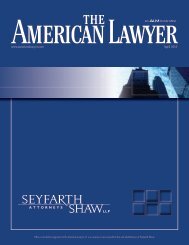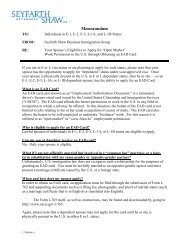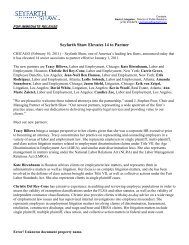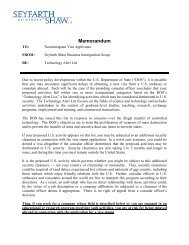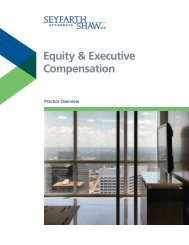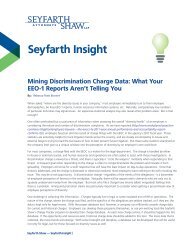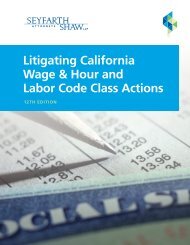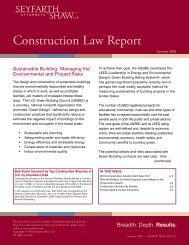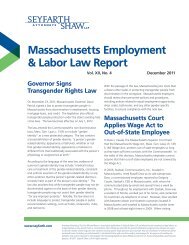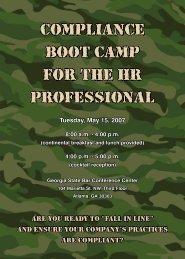Memorandum - Seyfarth Shaw LLP
Memorandum - Seyfarth Shaw LLP
Memorandum - Seyfarth Shaw LLP
Create successful ePaper yourself
Turn your PDF publications into a flip-book with our unique Google optimized e-Paper software.
Page 2<br />
measures. These new procedures can lead to extended delays that could prevent you from reentering<br />
the United States for weeks or months at a time. For this reason, we encourage you to<br />
consider traveling on an existing valid nonimmigrant visa stamp.<br />
If you already have an unexpired employment-based nonimmigrant visa stamp in your<br />
passport (such as an H-1B, L-1, or O-1), and if it matches your current immigration status, it may<br />
not be necessary for you to obtain a visa stamp in order to return to the United States For<br />
example, if you are in H-1B status, and already have an H-1B visa stamp in your passport that<br />
will remain unexpired on the day of your proposed return to the United States, then you do not<br />
require a new visa stamp. Instead, you may re-enter the United States with the existing visa<br />
stamp (even if it reflects the name of your former employer) and your original approval notice<br />
indicating your current employer.<br />
IV.<br />
Applying for the Nonimmigrant Visa at a U.S. Consular Post<br />
If the above alternative is not available to you and if you are required to travel<br />
internationally, then you will need to apply for the nonimmigrant visa stamp at a U.S. consular<br />
post while you are outside the United States.<br />
A. General Information About Timing<br />
With limited exceptions, getting a visa stamp now requires a personal interview, and<br />
many consular posts have significant (weeks or months) interview appointment lead times. It is<br />
usually difficult or impossible to accelerate the scheduling of an appointment. At many consular<br />
posts there may be an additional period of up to several weeks between the interview<br />
appointment date and the date the consular post returns the passport containing the new visa.<br />
To minimize potential delay and disruption of travel, if you are or will be required to<br />
obtain a visa stamp in order to enter the United States, you need to contact the U.S. Embassy or<br />
Consulate where you intend to process in order to book an interview appointment and to<br />
determine approximately how long it will take the consular post to issue the visa stamp and<br />
return your passport to you. Go to http://travel.state.gov/visa/temp/wait/tempvisitors_wait.php to<br />
access the web site for the U.S. consular post where you will process.<br />
Further, if you are a citizen of one of the countries affected by post-9/11 legislation -- or<br />
if your occupational field involves an area which could be considered by the government as a<br />
potential threat to U.S. security -- then you may encounter additional delays in visa processing.<br />
Please be aware that even if your country of citizenship is not included in the post-9/11<br />
legislation or if your line of work is in no way detrimental to U.S. security, a consular officer<br />
may, at his or her discretion, require you to undergo additional security screening. You can read<br />
more about the post-9/11 legislation (including the “NSEERS” or National Security Entry Exit<br />
Registration System) by visiting www.immstar.com and clicking on NIV Memoranda to access<br />
the document entitled “Nationalities Affected by Post 9/11 Legislation.” You can obtain more<br />
information about occupations that may be considered to involve risks to U.S. security by<br />
visiting www.immstar.com and clicking on NIV Memoranda to access the document entitled<br />
“Technology Alert List.”<br />
AT1 32610559.3


